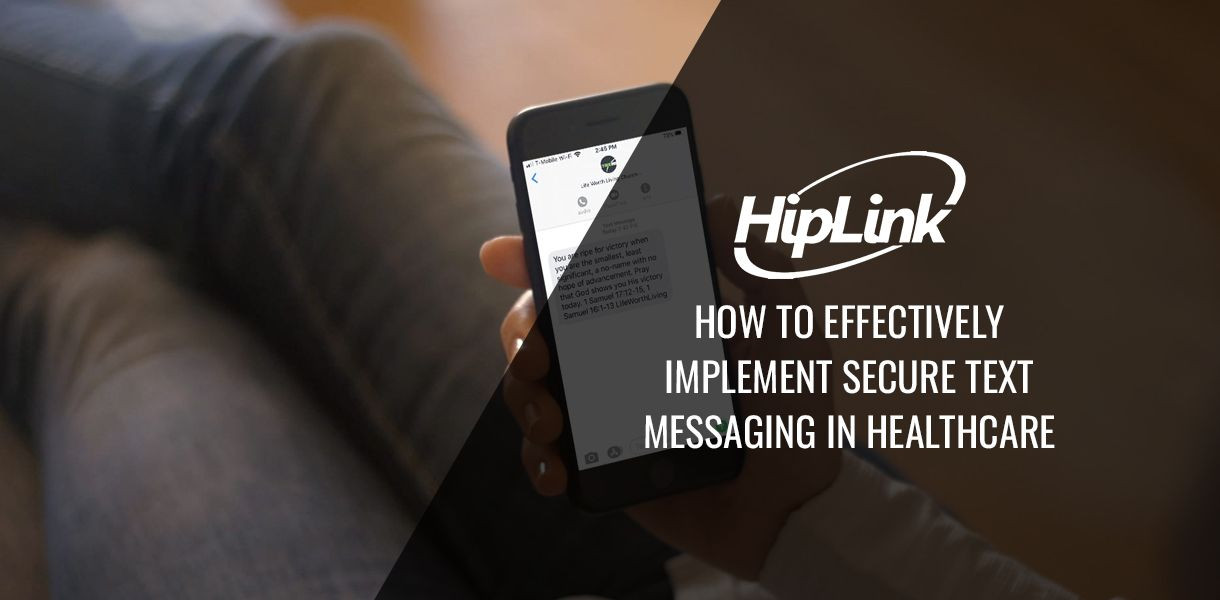Implementation of Secure Text Messaging (STM) affords healthcare providers a convenient, efficient method to communicate with colleagues in real time. Lab results, medication requests, and test results can all be sent and received via a secure, encrypted text messaging app.
However, implementation alone does not ensure usage of the STM app. Many healthcare providers may be skeptical of the new changes to the existing system. In order to augment adaptation, hospitals need to be driven and encouraging in their efforts to promote usage of the app. An internal marketing campaign, support from the IT department, and positive feedback from users are some ways this can be done.
Garner Support and Encourage Change
Procuring executive support and buy-in is crucial. To achieve this, the project leader or manager must demonstrate how STM tackles business problems and how it can be advantageous to the hospital, i.e., improved communication amongst healthcare providers, HIPAA-compliant, and improved patient satisfaction.
Additionally, influential end users can help stimulate change by being advocates of the new technology. When these users understand the benefits of STM to their daily work routines and the ease of use of the app, they will be eager to spread the word, resulting in others being enthusiastic about the new technology. Technologically experienced physicians who are held in high regard by their peers are imperative in this process. Colleagues tend to consider the opinion of a trusted source when determining their own stance concerning new technology.
Encouraging change within technology is actually quite simple with an STM app. Explaining that STM operates using the same methods as regular texting will immediately ease the transition into the new technology. Detailing the benefits STM brings to each individual using the app is also a key point. Does it save time? Does it provide quicker communication with a colleague that ends in better care for a patient? Incorporating clinical communications such as nurse call and code calls also offers workflow improvements to communicate more efficiently.
Promote the Advantages
Acceptance of STM also requires a marketing campaign. Preferably with the help of the marketing department, plan a promotional crusade that ensures everyone is aware of the app’s availability, the rollout schedule, training opportunities and, specifically, the benefits for the end users. Before the launch of the app, generate excitement with the help of newsletters, posters, banners, and blogs. It is much easier to integrate new technology at an event that everyone is looking forward to. Pre-launch blogs detailing the app and its ease of use as well as its many benefits can go a long way towards increasing enthusiasm.
The rollout event is as essential as the marketing campaign. To ease the transition, provide initial training, and answer questions, the event should have representatives from the IT department and from the vendor. Seeing the app and having any concerns addressed in person will help end users accept it and perceive it as simple and beneficial not only to themselves, but to the patients as well. Don’t forget to include the influential physicians and users as advocates for support at the event.
Provide a Dependable Infrastructure and Troubleshooting Process
Comprehensive Wi-Fi and mobile coverage throughout all hospitals and affiliate locations is absolutely essential. Lack of an excellent wireless and cellular signal not only leads to frustrated users, it can also have a devastating effect on the quality of patient care. Critical messages that are delayed by a poor signal are unacceptable in a hospital setting. Additionally, users who get frustrated by a poor network will not adapt to the STM.
As with all technology, many things can occur that affect the functionality of the app. A problem with the app, data accuracy of the contact directory, device settings, and more can all cause a glitch. Implementing a self-service FAQ comprehensive database of the most common questions and troubleshooting problems will save time and solve the simplest of problems. For more complex issues, a service desk can be established. Users should have multiple means of accessing the service desk, including an avenue in the app itself. Users who have a difficult time getting help when they have problems are likely to give up and return to the old, unsecure texting to communicate with others. By getting quick answers and solutions to their problems, users are much more likely to engage with the app.
Plan and Deliver
For an STM app to be successfully adopted, it requires an excellent user experience. As with all apps, most people blame one glitch on the app itself when the problem may actually be something else entirely such as poor cellular network coverage. To prevent this, IT should test the app extensively to ensure a smooth user experience.
In-depth planning and preparations will help you deliver a more successful rollout to augment acceptance and enthusiasm of the STM app which is an invaluable, efficient communication tool that saves time and speeds the delivery of patient care. For more information about HipLink and our STM app, contact us at 1-800-524-7503.



